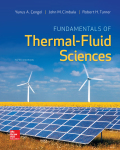
Concept explainers
The temperature and total enthalpy at initial and final states in the container.
The temperature and total enthalpy at initial and final states when the heating is completed.
Explanation of Solution
Given:
The mass of a refrigerant R-134a
The volume of a rigid container
The final pressure of the container is
Calculation:
Since the process is a constant volume, calculate the specific volume.
Here, specific volume at states 1 and 2 are
Refer to Table A-12, obtain the values of below variables as in Table (I).
| Pressure, kPa | Temperature, |
| 280 | –1.25 |
| 300 | ? |
| 320 | 2.46 |
Write the formula of interpolation method of two variables.
Here, the variables denote by x and y are pressure and temperature.
Thus, the initial temperature
The initial state represents the mixture, so temperature to be considered as the saturation temperature at given pressure.
Similarly, calculate the values of
Calculate the dryness fraction at state 1.
Here, specific volume at saturated water is
Substitute
Calculate the specific enthalpy at state 1.
Here, specific enthalpy at saturated liquid is
Substitute
Calculate the total enthalpy at state 1.
Here, mass of the refrigerant R-134a is m.
Substitute 10 kg for m and 54.56 kJ/kg for
Thus, total enthalpy final states in the container is
Similarly, calculate for
Here, dryness fraction at state 2 is
Calculate the specific enthalpy at state 2.
Calculate the total enthalpy at state 2.
Similarly, calculate the values of
Repeat the above steps for
Thus, the temperature and total enthalpy at initial and final states in the container are
Want to see more full solutions like this?
Chapter 4 Solutions
EBK FUNDAMENTALS OF THERMAL-FLUID SCIEN
 Elements Of ElectromagneticsMechanical EngineeringISBN:9780190698614Author:Sadiku, Matthew N. O.Publisher:Oxford University Press
Elements Of ElectromagneticsMechanical EngineeringISBN:9780190698614Author:Sadiku, Matthew N. O.Publisher:Oxford University Press Mechanics of Materials (10th Edition)Mechanical EngineeringISBN:9780134319650Author:Russell C. HibbelerPublisher:PEARSON
Mechanics of Materials (10th Edition)Mechanical EngineeringISBN:9780134319650Author:Russell C. HibbelerPublisher:PEARSON Thermodynamics: An Engineering ApproachMechanical EngineeringISBN:9781259822674Author:Yunus A. Cengel Dr., Michael A. BolesPublisher:McGraw-Hill Education
Thermodynamics: An Engineering ApproachMechanical EngineeringISBN:9781259822674Author:Yunus A. Cengel Dr., Michael A. BolesPublisher:McGraw-Hill Education Control Systems EngineeringMechanical EngineeringISBN:9781118170519Author:Norman S. NisePublisher:WILEY
Control Systems EngineeringMechanical EngineeringISBN:9781118170519Author:Norman S. NisePublisher:WILEY Mechanics of Materials (MindTap Course List)Mechanical EngineeringISBN:9781337093347Author:Barry J. Goodno, James M. GerePublisher:Cengage Learning
Mechanics of Materials (MindTap Course List)Mechanical EngineeringISBN:9781337093347Author:Barry J. Goodno, James M. GerePublisher:Cengage Learning Engineering Mechanics: StaticsMechanical EngineeringISBN:9781118807330Author:James L. Meriam, L. G. Kraige, J. N. BoltonPublisher:WILEY
Engineering Mechanics: StaticsMechanical EngineeringISBN:9781118807330Author:James L. Meriam, L. G. Kraige, J. N. BoltonPublisher:WILEY





